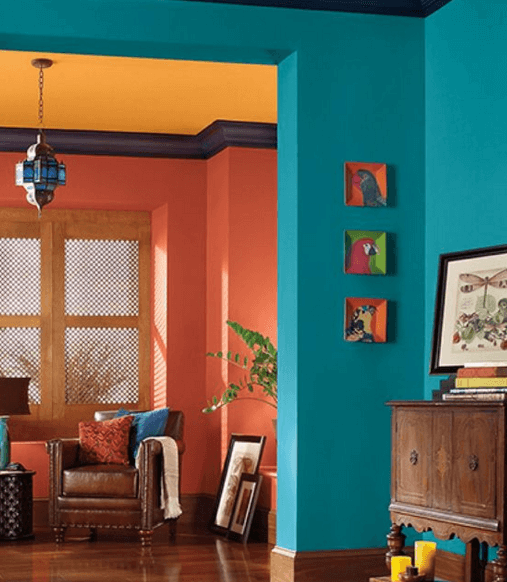




Where are Sheens typically used and why?
Gloss:
Typically used on broken up and smaller areas such as interior and exterior trim.
Pros – Easily cleaned and more durable
Cons – Flashes more easily, especially in large areas, exceedingly difficult to touch up, roller, brush strokes, spray passes and flaws in the substrate are extremely visible.
Flat:
Typically used on ceilings and walls/siding
Pro – Generally does not flash on large areas, touches up best. Roller, brush strokes, spray passes and flaws in the substrate are significantly less visible. Thus, it has the best appearance. This is best for older homes and homes requiring excessive drywall/plaster repair.
Cons – Does not clean easily and is less durable
Mid Sheen:
Named differently depending on the paint brand and product line. One common mid sheen is “eggshell” or “Satin” for example.
Pros – More durable and washable than flat. Richer colors with a warm glow.
Cons – Substrate imperfections, roller to bush lines and spray passes are more visible.
Low Sheen:
These are typically called “flat enamel”, “low sheen” or “matte”. This is our favorite sheen for walls as they are still washable, provide a mild glow and hide imperfections more than mid sheens. We find this sheen to be the best balance between looks and durability for walls.
Sheen Summary:
Sheen selection is always a balance of looks versus durability. You want more durability in kitchens, bathrooms, and high traffic areas while in well lighted large areas such as a two-story family room you may want to opt for a flat sheen. Items heavily handled that require frequent cleaning such as a door would suggest a gloss finish.
One versus two versus three-coat coverage
One coat coverage is highly successful only when painting over a previously painted surface using the previously painted color and sheen.
It is virtually impossible to determine with 100% reliability if a color change can be accomplished with 2 coats because there are millions of colors, substrates, and paint product combinations. The information below is for guidance but is not guaranteed.
Cool Neutrals:
Changing from one cool neutral color such as shades of white, cream, ivory, light grays, blues, and silvers to another of the same depth usually covers in:
Interior: 2 coats when brushed and rolled
Exterior: 1 coat when sprayed, 2 coats when brushed and rolled
Warm Neutrals:
Changing from one warm neutral color shades of browns, tans, golds, beige, dark grays, black to another of the same depth usually covers in:
Interior: 2 coats when brushed and rolled
Exterior: 1 coat when sprayed, 2 coats when brushed and rolled
More Drastic Color Change:
Changing a warm neutral color to or from a cool neutral color may require more than 2 coats depending on the contract. To change from pure black to pure white for example usually requires more than 2 coats. Most often a customer will purchase two coats and will determine if a third coat is desired after the two-coat application.
Primary Bright Colors:
Changing from or to a bright primary color such as red, orange, yellow, green, blue, violet, and bright whites usually require more than 2 coats. In most cases, it is best to plan on 3 coats upfront utilizing a tinted primer and two coats of paint. When available and applicable it is also best to utilize a red or yellow base paint. Red and yellow-based paints do not come in all product lines. These will usually cover in 2 coats on the exterior when sprayed especially if a red or yellow-based paint is applicable and available.
Color Change Summary:
You may rely on one coat coverage when painting over with the same color and sheen with minimum repairs. In all other cases, it is best to plan on at least two coats for complete uniform coverage. Keep in mind, substrates in need of lots of repairs will require two coats in addition to spot priming.
Oil Versus Water Based Paints:
Surfaces previously painted with oil-based paints will require recoating with an oil-based paint or oil primer prior to painting with a water-based product. Dip a cotton ball into a small amount of denatured alcohol. Rub it over a small area on the surface. If the paint comes off, it is water-based paint. Most residential projects will use all water-based products. Some items such as trims, cabinets, or decks in the past were commonly painted in oil and in recent years have diminished due to environmental concerns.
In Summary:
Your final selections are always based on your desired durability, appearance, cost, and compatibility.
